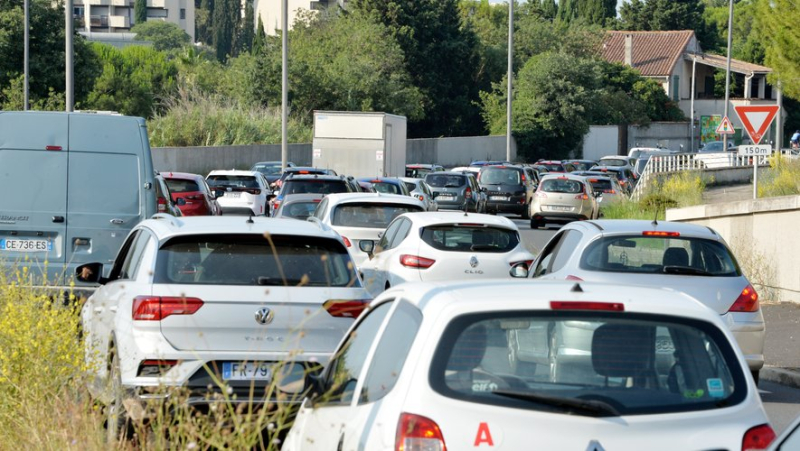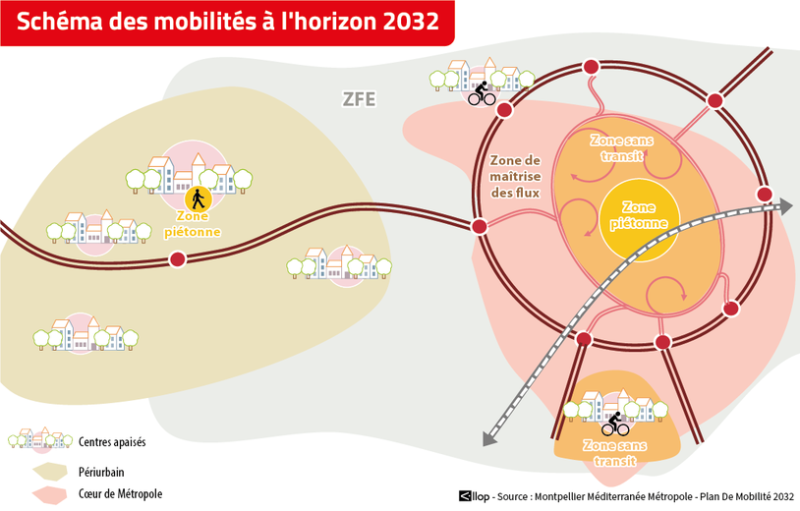“Reducing transit traffic in urban centers”: the car, the main target of the future mobility plan in the Montpellier Metropolis

“Le transport est la cible privilégiée pour réduire les émissions de polluants”, indique le document. Midi Libre – MICHAEL ESDOURRUBAILH
The objective of the 2032 mobility plan, currently being prepared, is to reduce the share of vehicles from 58% to 45% of all daily transport. And to increase the share of bicycles from 2% to 15%.
What organization of transport by 2032 in the Metropolis? The deadline may still seem far away, but it is today that the architecture of the networks that will be developed in the medium term is being decided. This scheme even constitutes a "legal obligation" as recalled by the community leaders in the middle of last week, during a public meeting on the subject.
While it is still at the advanced stage of reflection, before its official approval by the Metropolitan Council (see the calendar opposite), the mobility plan already displays a certain number of objectives to be achieved. And the first of these is clearly stated, which corresponds to the desire to combat air pollution and CO2 emissions: reducing the use of cars or similar vehicles for professional and leisure purposes. "Given the absence of industrial activity in the territory, transport is the preferred target for reducing pollutant emissions" specifies the document presented.
Approval as early as next July
The development and validation of the mobility plan for the Metropolis. At the end of this public meeting led by the Director of Mobility at the Metropolis, Jean-Michel Evin, a precise timetable was established. The plan as presented will be submitted to intercommunal elected officials on October 8.
A public inquiry will then be opened in the first quarter of 2025 with a view to approval scheduled for next July. During the meeting, several participants lamented the short time they were given to influence the initial version of the plan.
Cycling would increase from 2% to 15% of trips
In 2032, the ambition is to reduce the “modal share” of vehicles from 58% in 2019 to 45% in eight years. Conversely, the place of the bicycle in these journeys would increase from 2% in the same period to 15%, that of public transport from 18 to 20%. To achieve this change in usage, the travel plan is based on actions aimed at increasing the number of independent living areas, "calm centres" following the concept of "the quarter-hour city". In short, to "reduce transit traffic in urban centers".

Modify the delivery chain
Around Montpellier, this involves in particular “enhancing the structuring road network and in particular the bypass” and “organizing the links in the urban logistics chain". According to a 2020 study, deliveries represent nearly 220,000 kilometers traveled every day and an emission of 50% of fine particles in the city. To support the “behavioral and energy transition” of uses, the plan intends to continue to rely on the establishment of a ZFE (low emission zone). During the consultation process, the mobility committee made up of individuals, however, highlighted the obstacle posed by “the budgets to be mobilised for the purchase of electric vehicles”.
These business areas forgotten by alternative modes of transport to the car
The diagnosis of the mobility plan highlights a difficulty that has been well identified for several years: the deficit in public transport service in several business areas. These are more particularly the Millenaire and Salaison parks (Vendargues), Euromédecine, Prés d’Arènes and, finally, Lauze (Saint-Jean-de-Védas). The diagram evokes “a service to economic hubs to be improved” including for infrastructure dedicated to soft mobility.
According to the elements presented, the car represents three-quarters of transport in these areas, compared to just over a quarter in the old centre of Montpellier. Bus-tram line 1 should help to partially erase this weakness for the Millénaire while one of the recommended actions is to "rationalize car use" ` through car sharing and carpooling. The objective is also to support employers in their ecological transition process.
Residents' questions
Beyond this remark, the public meeting in which no elected official participated, marked the questions of a certain number of residents, first and foremost those of the four boulevards. “Our example is in contradiction with what you want to do. This discredits the overall approach” indicated its representative Alain Makinson. “In this strategy there is a major contradiction, which is the place of the car while the COM (western bypass of Montpellier) will induce even more cars. “It's an unthought-of thing” observed Arnaud, from Chamberte.
Also present, the president of Vélocité, Nicolas Le Moigne deplored the "lack of consultation" prior to the development of this plan. While urging the community to accelerate the creation of infrastructure to promote travel by bicycle. Before 2032.
I subscribe to read the rest




